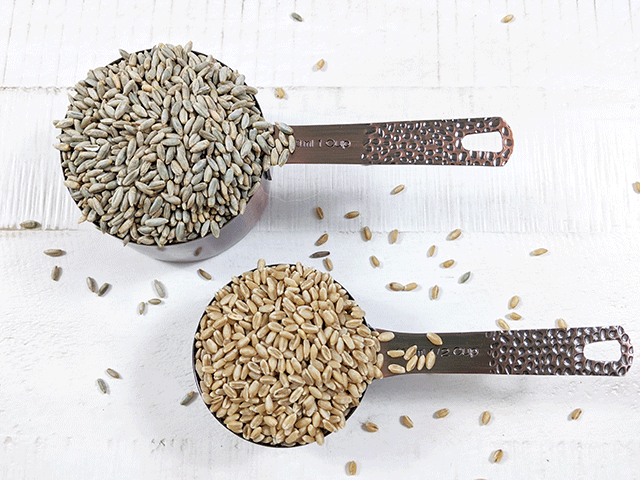
Spring of 2020 was a crazy time. Well, actually, 2020 itself was a mess. But spring, in particular, had me on edge.
Utah had several minor earthquakes. The Covid pandemic resulted in a lot of panic shopping, so certain basic items were scarce. And the stock market crashed. Although the crash, didn’t affect my family directly, it did contribute to the overall air of unease. It made me worried about the economy and if our finances would be able to absorb the hit.
And then the stimulus checks came.
Like many other families, my husband and I used the money to cover expenses. We paid some of our credit card debt. We stocked up on essential food items. And we put some money into savings in case my husband lost his job.
But with some of the extra money, I also bought an at-home mill, more specifically a Wondermill Grain Grinder. I figured the mill would come in handy for a variety of reasons.
3 Reasons to Mill Your Own Flour
Before I delve too deep into the nitty gritty of grinding wheat, I want you to know that a mill isn’t the right solution for everyone. Mills can be expensive, noisy, and messy. Some mills have a learning curve. Home-ground flours don’t have the same consistency as store-bought flours. Depending on where you live, wheat berries and other grains may be more difficult to purchase, and therefore, more expensive.
However, if you still wonder whether you should mill your own flour, here are a few pros to consider.
1. You Can Store Grain in Bulk for Emergencies
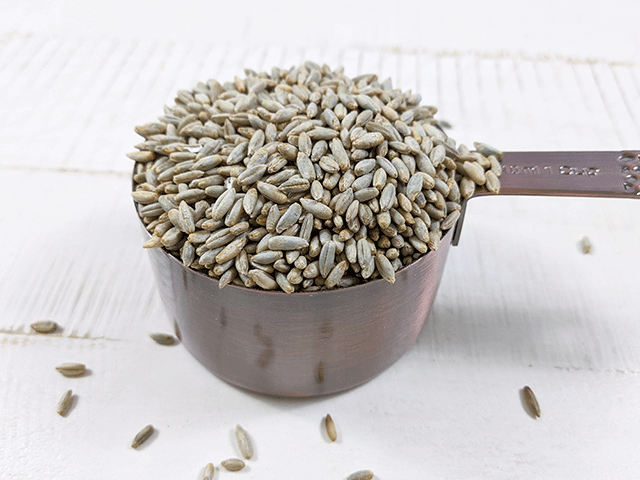
During the first few weeks of the pandemic, many store shelves ran out of flour. Although Walmart and Smith’s tried to stay on top of stocking supplies, panic buyers kept clearing them out again.
Fortunately, my local Costco also had several buckets of wheat. I bought a 45 lb. bucket of hard white wheat for about $15. With my newly purchased mill, I could make my own wheat flour even when the stores had run out.
Better still, I didn’t have to mill all my wheat at once. I only had to mill what I needed for the next few weeks and store the rest. According to the container, the wheat berries could last 30 years if stored in a cool, dry place.
Now, I can make flour at my leisure, and during an emergency, I can skip going to the store. If you like to feel prepared, you should mill your own flour.
2. You Can Skip the Preservatives and Additives
I’m going to be up front about myself right now: I’m cheap.
For most of my day-to-day baking, I stock up on Great Value’s All-Purpose Flour. It’s easy to buy in bulk, and most of the time, it’s available for only $0.22 a pound. It might not be flashy, but it gets the job done and keeps my family fed.
However, like so many other store-brand flours, Great Value’s all-purpose flour comes “enriched” and “bleached.”
- Enriched – During processing, some nutrients are lost. If your flour comes enriched, it means those nutrients are replaced.
- Bleached – Bleached flour includes whitening agents, maturing agents, or both.
While these additives are harmless, they can affect the flavor and smell of the flour. You can bake the flour to improve the odor, but if you want a better flavor experience, you’ll need a higher quality flour. And higher quality costs money.
Or you can skip the additives and mill your own flour.
When you mill your own flour, you use the entire berry or grain, so none of the nutrition is lost. Additionally, you don’t need to make your flour look blindingly white through bleaching agents. You have great tasting flour from start to finish. Better still, you don’t have to worry about what manufacturers have done to keep it on the shelf longer.
3. You Can Experiment With More Grains
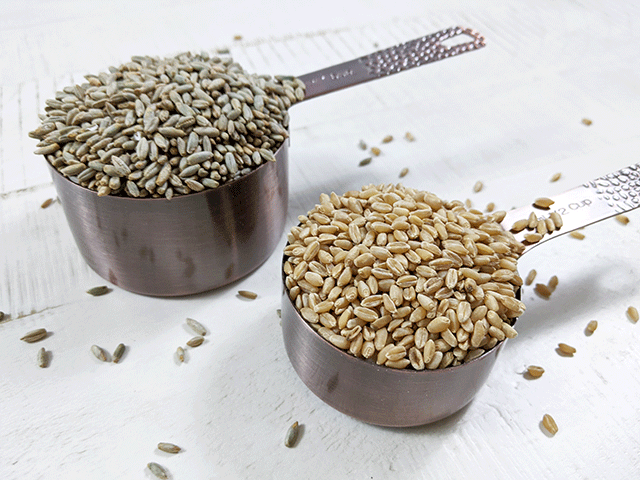
My local Walmart has a limited variety of flour. I can choose between all-purpose or whole wheat. Occasionally, I’ll see some bread flour or some cake flour, but they often cost more than I’m willing to pay.
If I feel like making one of my rye bread recipes, I’d have to go to a specialty store. If I need rice flour to keep dough from sticking or to make gluten-free bread, I’m out of luck. I could buy barley flour or spelt flour from Amazon, but, as I mentioned earlier, I’m cheap. Specialty flours cost two to three times as much as simple flours. Even worse, I’d have to cover the cost of shipping them to my house as well.
But with a mill, I have a much wider variety of flours (and subsequently, flavors) to use in my baking.
If I ship from Amazon, a bag of rye flour can cost $0.37 an ounce whereas a bag of rye berries only costs $0.14 an ounce, so milling my own flour cuts the cost to a more reasonable amount. Similarly, a bag of barley flour can cost about $0.54 an ounce, while a bag of pearl barley costs about $0.23 an ounce.
With grains and berries at half the price of their corresponding flours, I feel much more comfortable mixing, matching, blending, and experimenting with my bread recipes. And I can do it while staying within my budget.
If you like to experiment with flavor profiles, you should mill your own flour.
Do You Save Money?
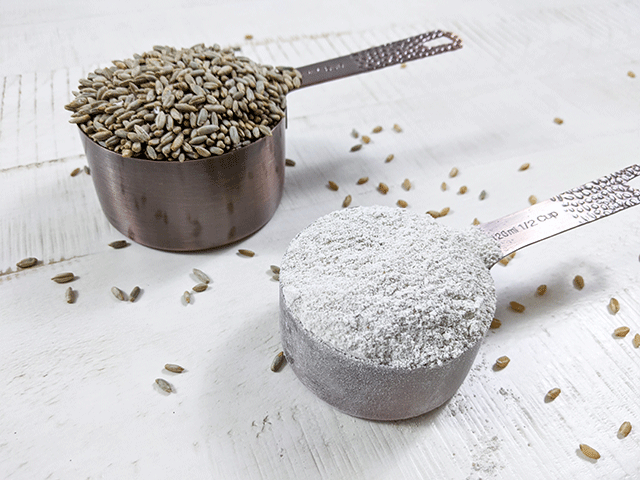
I’m all about saving money wherever I can, and I’m going to answer this question as thoroughly and honestly as I can.
If you want the short answer: yes, you can save money.
Want the longer answer? You can save money, but it will take a while to break even, and you’ll need to think carefully about what you buy.
If you mill your own flour, you’ll need to keep in mind the following:
- The cost of your mill
- The cost of your grain
- The cost of electricity
- The cost of shipping
You may also want to consider storage space, how often you bake bread, and how much time and energy you want to use when you mill your own flour.
A Closer Look at Mills
First, let’s take a look at some of the more popular mills on the market.
- Manual Tabletop Grain Grinder, Generic Brand = $40.38 at Walmart
- KitchenAid Wheat Grinder Attachment = $150 at Amazon*, Lowe’s, and Home Depot
- Wondermill Grain Grinder = $259.95 at PleasantHillGrain and Roots and Harvest
Of course, there are a lot more mills available than these three. Feel free to shop around and see what’s out there.
I am am Amazon associate, so I do earn money from affiliate links. However, I don’t earn money for my opinions, and I only list this product here as an example of a popular mill.
A Manual Grinder
If you want the cheapest option possible, you can buy a generic brand manual grain grinder from Walmart or from Amazon or from a similar store near you. A manual grain grinder is a good option if you want to have a way to grind wheat during an emergency and you don’t have access to electricity. It takes up little space, and you can just clamp it onto your table top and get to work.
But a manual grain grinder doesn’t make fine flour. You may run your wheat through the grinder multiple times and will still end up with some crunchier bits that will affect the texture of your bread. Additionally, manual grain grinders take a lot of muscle power. You may mill your own flour at your own speed, but you’ll wear yourself out for a few cups of gritty flour.
A Grinding Attachment
If you want the next cheapest option, you can buy a wheat grinder attachment for $150 at multiple locations. I’ve seen these in several stores, and they’re all about the same price. You can attach the grinder to the front of your KitchenAid mixer and work from there. It’s also fairly small, and it has multiple settings so you can choose how fine you want your flour.
However, this attachment only works if you already have a powerful KitchenAid mixer, which can cost $250 or more. If you don’t already have a KitchenAid, you’re looking at a $400+ purchase altogether, making it the most expensive option. Additionally, many KitchenAid attachment users warn that the attachment shouldn’t pair with the smaller artisan mixers, as it could blow out the motor. The attachment gets hot after use, so if you plan to make more than 10 cups of flour at a time, you might need a more efficient option.
An Electric Grinder
And now a look at the third option, the Wondermill. This is the mill I chose as an amateur baker. It was available at a few smaller sites, and those sites did run out of stock about the same time flour became scarce during the pandemic. However, they did a great job restocking, and it’s available again. The mill itself works quickly. It can easily grind 12 cups of flour in a matter of minutes, and the flour goes into a covered bowl attachment to keep messes minimal.
But you should know the mill only has three milling options for flour: coarse, bread, and pastry. And I have noticed that if you don’t completely lock the lid into place on the flour bowl that flour will poof out into a powdery mess during milling. The mill handles a variety of grains fine, including rice, wheat, and rye. However, do not try to make almond flour with the mill, as the oils will gunk up the system.
Additionally, advertisers claim you can store your freshly milled flour in the covered container, but there is an open hole where it attaches to the mill. If you have a problem with insects in your house, you’ll want an alternative storage solution for when you mill your own flour.
Of course, these are just a few popular milling options. You might find a better deal elsewhere, but be sure to read reviews and thoroughly understand the pros and cons of each before you invest.
A Closer Look at the Math
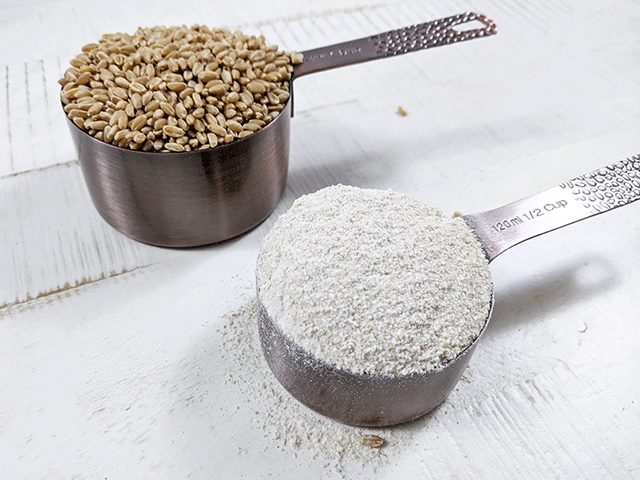
This is the part where I do math. I’m not great at mathematics, so feel free to correct me or point out any errors in my reasoning here. However, I think it’s important to crunch some numbers before giving a hard and fast “yes” on whether you should mill your own flour.
If you read my “experiment with grains section earlier”, you’d see that you can save about $0.23 an ounce if you buy rye berries rather than rye flour. And you can save about $0.31 an ounce if you buy pearl barley rather than barley flour.
But let’s take a look at regular wheat flour, the cheapest and most common flour to mill.
The Cost of Wheat
I purchased a 45 lb. bucket of hard white wheat for $15 at Costco. At that price, wheat totals about $0.33 a pound or $0.02 an ounce. I understand that in some locations, you might not find wheat in bulk for that price, but I’m working with what I have access to right now.
Additionally, a cup of wheat berries actually makes more than a cup of wheat flour. In general, a cup of wheat berries makes closer to a cup and a half of wheat flour, taking the price per ounce down even further.
To break it down, 45 pounds = 720 ounces. A cup of wheat berries weighs 6.3 ounces, which means a Costco bucket holds about 114 cups of wheat berries. If a cup of wheat berries makes a cup and a half of flour, then a bucket makes 171 cups cups of wheat flour (plus a little extra).
A cup of flour weighs 4.5 ounces, so a bucket would make about 771 ounces of flour for $15, bringing the price to about $0.31 a pound or $0.019 an ounce.
Keep in mind that this is for pure whole wheat flour, not all-purpose flour (which requires additional sifting to imitate). I have yet to see a Great Value brand whole wheat flour, so let’s compare it with the Wheat Montana Bronze Chief Whole Wheat flour, as that is the current budget pick at $0.05 an ounce.
If you mill your own whole wheat flour, you’d save $0.03 an ounce or $0.49 a pound. Note that this does NOT include the cost of shipping, taxes, or electricity, which I have no idea how to calculate at this point.
How Long Until You Break Even?
To continue my hypothetical, you’d have to mill 530 pounds of flour to break even (if you purchased the Wondermill at $260). Assuming my math is still in the right ball park at this point, you’d need to mill 1,886 cups of flour.
I know bread recipes and amounts vary widely, but let’s assume that the average loaf of whole wheat bread contains about 3.5 cups of flour. You’d need to make 539 loaves of bread before you recoup the cost of your mill.
If you only made about a loaf of whole wheat bread a week, it would take you 10 years to break even. So, not exactly promising if you are a casual baker.
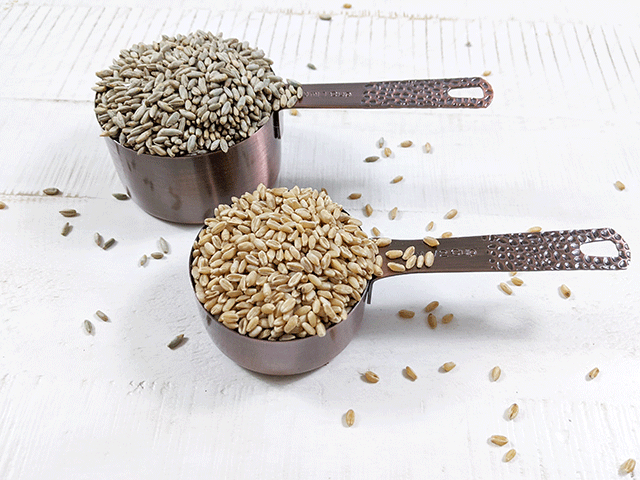
However, I tend to make at least two loaves a week (more if I’m trying to master a recipe or if I’m feeling generous and want to gift bread to friends). At two loaves a week, I’ll still need 5 years of casual baking before I start to save money on flour, not including the cost of shipping, taxes, and electricity. According to the manufacturers, the Wondermill has a lifetime warranty on milling heads and only a 6 year warranty on everything else.
Is a Mill a Good Investment?
I understand that this has been a lengthy post, and I totally get it if you’d rather not read everything in depth. So here’s a quick recap.
If you want to mill your own flour, you have a mix of pros and the cons. In favor of milling, you can make flour at your own leisure, enjoy better flavor and nutrition from your flours, and experiment with a variety of grain. Ounce to ounce, home-milled flour tends to be cheaper than store-bought flour, so you have the potential to save money.
However, don’t forget that mills can cost quite a lot. If you are a casual baker on a tight budget, you’ll need to carefully consider whether you can foot the bill upfront and whether you want to wait five years (or more) before you see any real savings. In some locations, finding flour on the shelves may actually be cheaper than shipping grains to your home or buying them at a specialty store.
Despite the cons, I love milling my own flour at home, and I think the purchase was a good investment for me personally. But be sure to weigh all the pros and cons before you purchase a mill to mill your own flour.

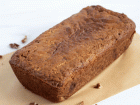
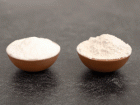

I’m serious considering/planning on going down this road after the horrorfying realization “they” are poisoning us!
Which grain should be good to start with?
I think wheat is one of the easiest and most affordable grains to start milling, but it really depends on what is accessible to you in your area. Locally sourced grain is often the best way to go.
It seems like milling at home would only produce whole grain flour. Is there a way to make regular flour with a home mill? If sifting is the way can you know what your percentage of bran, germ and endosperm is when complete?
Those are very valid points and concerns. As far as I can tell, the only way to make a flour similar to all-purpose if you’re milling at home is to sift it. The more you sift, the more bran you remove. You may have to sift the four two or three times to get the flour you’re looking for. The best Way to determine percentages would be to measure the weight of the flour before you begin, the measure the weight of the bran you remove after sifting. Then you can calculate the percentage from there.